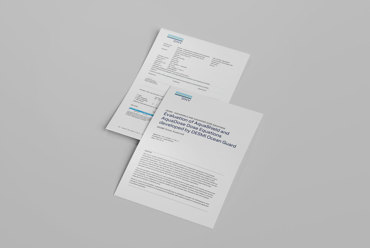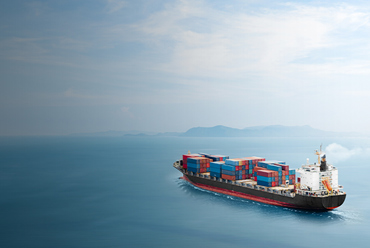
May 2024

January 2015
DESMI has introduced a new oil spill recovery product, Ro-Kite, combining it with a DESMI SpeedSweep boom and Ro-Skim skimmer to make cleaning up spills with just one vessel far easier, faster and more cost-effective.
One system does it all
Every now and then, something comes along that makes a real difference to the way an industry works. The latest addition to the portfolio of oil spill recovery solutions from market leader DESMI is one such product.
Christened “DESMI RO-Kite”, the new acquatic device, which is designed to replace the functions of a second vessel, has been eagerly anticipated by DESMI’s customers. In fact, RO-Kite can turn single-vessel oil spill recovery from a last-resort, difficult-to-handle alternative into the first choice for a wide range of spill situations. And, together with other products in DESMI’s oil spill recovery portfolio, it boasts a long list of advantages to back such a claim.
Single-vessel blues
It doesn’t take a genius to work out that deploying and coordinating two vessels to operate an oil spill recovery boom between them is more expensive and logistically challenging than one. However, although single-vessel solutions have been in existence for some years, their use has been severely limited by a number of problems – mostly associated with the size, weight and rigidity of the equipment, as well as the comparatively slow speed at which it can be operated.
DESMI’s new solution is different. By combining RO-Kite with two other, well-proven products, DESMI SpeedSweep boom and DESMI RO-Skim, the company has managed to create a system that makes cleaning up oil spills using a single vessel far easier, faster and more cost-effective.
“In decades of working in this field, we’ve seen a variety of ways to operate with a single vessel system,” says DESMI. “Many have used a jib and a float attached to the stern and aft to keep the sweep in shape. But that’s too complicated. Today, the best approach is to use an aquatic device. The few devices already on the market, however, have presented their own set of difficulties.”
DESMI’s RO-Kite promises to change things for the better – and it is a key component of the company’s single-vessel system. Deployed behind the recovery boom, RO-Kite helps to keep the shape of the sweep, while the RO-Skim skimmer located at the apex removes the contained oil from the apex. At the same time, the heavy-duty, rubber SpeedSweep boom with its multiple permeable barriers boosts the speed at which oil can be recovered from the industry standard of 0.7 knots to as much as 3 knots. That’s a lift of more than 350 percent – and it’s clear evidence that, properly equipped, one vessel can easily perform the work of two.
Cost and handling benefits
Of course, experienced recovery vessel operators know that operating at higher speeds is just one side of the equation. Ease of equipment handling is every bit as important.
The new combined system provides significant cost-savings for oil spill response contractors. Unlike other systems, which include a number of loosely connected devices in the apex, the DESMI solution guarantees easier maintenance, as well as fewer possible problems. And thanks to the light weight of the RO-Kite, the entire system can be launched without the need for a deck crane.
It’s clear that a lot of thought has gone into the handling of DESMI’s single-vessel solution. For example, where conventional booms incorporate a rigid, usually foam-filled flotation device, the RO-Kite is buoyed by air. To inflate the RO-Kite, crew can use the same air pump as used to deploy the SpeedSweep’s boom, further easing handling, transport and storage.
The list of advantages stacks up to a far safer solution, too, which is sure to please the Health and Safety departments of both contractors and their oil company clients. With fewer devices on deck, the potential for accidents is reduced – and the absence of a crane is perhaps the most compelling of these benefits.
But it’s not just the crew that can operate under safer conditions. With rubber replacing rigid components as much as possible throughout the solution, there are fewer parts that could damage the hull of the vessel during operation. And that alone delivers new cost savings.
Single supplier interface
“We’ve managed to create a complete, single-vessel oil spill recovery system using DESMI products alone,” says DESMI. “The skimmer is made from our material, we use a DESMI pump, even the self-floating umbilical hose from the skimmer to the vessel is a DESMI product.”
The combination is proving to be a powerful argument for equipment buyers, partly because most oil spill recovery contractors prefer not to deal with multiple suppliers for components or technical support when disaster strikes and fast problem-solving becomes crucial.
Self-floating hose sleeve
The hose DESMI mentions is itself a noteworthy innovation. Called the ZUH (Zipper Umbilical Hose), it resembles a large, sleek anaconda – albeit one that can easily be opened or closed with a bright yellow zipper! Snugly housed within this self-floating sleeve are the individual hoses required for transporting oil from the skimmer to the vessel’s holding tank. Its key advantage, then, is that it collects multiple hoses cleanly and simply, while removing the need to attach multiple flotation devices to each hose. Moreover, the oil skimmer fitted at the end of the ZUH can be operated both during winding off and while on the reel.
Worth the investment
According to DESMI, the oil spill recovery market can expect to quickly gain advantages from the combined DESMI products:
“The DESMI RO-Kite and our single-vessel system really stand out. By turning single-vessel systems into a smart choice instead of a poor alternative, we can make an extremely worthwhile difference to how much oil can be recovered – in a shorter timeframe, with fewer resources and greater safety.”
At first, DESMI is offering its single-vessel system – and comprehensive hands-on training – for small to medium-sized vessels operating in open coastal waters. And an offshore model that can be used by larger vessels is currently in development.





May 2024

February 2024

February 2024

August 2023